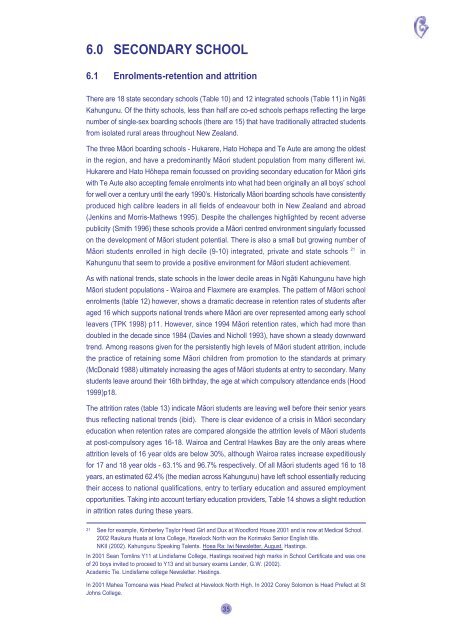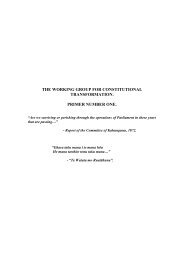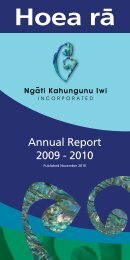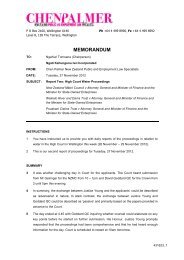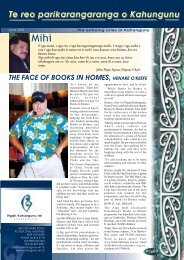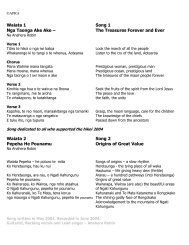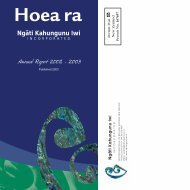Matauranga Strategy - NgÄti Kahungunu Iwi Incorporated
Matauranga Strategy - NgÄti Kahungunu Iwi Incorporated
Matauranga Strategy - NgÄti Kahungunu Iwi Incorporated
Create successful ePaper yourself
Turn your PDF publications into a flip-book with our unique Google optimized e-Paper software.
6.0 SECONDARY SCHOOL<br />
6.1 Enrolments-retention and attrition<br />
There are 18 state secondary schools (Table 10) and 12 integrated schools (Table 11) in Ngäti<br />
<strong>Kahungunu</strong>. Of the thirty schools, less than half are co-ed schools perhaps reflecting the large<br />
number of single-sex boarding schools (there are 15) that have traditionally attracted students<br />
from isolated rural areas throughout New Zealand.<br />
The three Mäori boarding schools - Hukarere, Hato Hohepa and Te Aute are among the oldest<br />
in the region, and have a predominantly Mäori student population from many different iwi.<br />
Hukarere and Hato Höhepa remain focussed on providing secondary education for Mäori girls<br />
with Te Aute also accepting female enrolments into what had been originally an all boys’ school<br />
for well over a century until the early 1990’s. Historically Mäori boarding schools have consistently<br />
produced high calibre leaders in all fields of endeavour both in New Zealand and abroad<br />
(Jenkins and Morris-Mathews 1995). Despite the challenges highlighted by recent adverse<br />
publicity (Smith 1996) these schools provide a Mäori centred environment singularly focussed<br />
on the development of Mäori student potential. There is also a small but growing number of<br />
Mäori students enrolled in high decile (9-10) integrated, private and state schools 21 in<br />
<strong>Kahungunu</strong> that seem to provide a positive environment for Mäori student achievement.<br />
As with national trends, state schools in the lower decile areas in Ngäti <strong>Kahungunu</strong> have high<br />
Mäori student populations - Wairoa and Flaxmere are examples. The pattern of Mäori school<br />
enrolments (table 12) however, shows a dramatic decrease in retention rates of students after<br />
aged 16 which supports national trends where Mäori are over represented among early school<br />
leavers (TPK 1998) p11. However, since 1994 Mäori retention rates, which had more than<br />
doubled in the decade since 1984 (Davies and Nicholl 1993), have shown a steady downward<br />
trend. Among reasons given for the persistently high levels of Mäori student attrition, include<br />
the practice of retaining some Mäori children from promotion to the standards at primary<br />
(McDonald 1988) ultimately increasing the ages of Mäori students at entry to secondary. Many<br />
students leave around their 16th birthday, the age at which compulsory attendance ends (Hood<br />
1999)p18.<br />
The attrition rates (table 13) indicate Mäori students are leaving well before their senior years<br />
thus reflecting national trends (ibid). There is clear evidence of a crisis in Mäori secondary<br />
education when retention rates are compared alongside the attrition levels of Mäori students<br />
at post-compulsory ages 16-18. Wairoa and Central Hawkes Bay are the only areas where<br />
attrition levels of 16 year olds are below 30%, although Wairoa rates increase expeditiously<br />
for 17 and 18 year olds - 63.1% and 96.7% respectively. Of all Mäori students aged 16 to 18<br />
years, an estimated 62.4% (the median across <strong>Kahungunu</strong>) have left school essentially reducing<br />
their access to national qualifications, entry to tertiary education and assured employment<br />
opportunities. Taking into account tertiary education providers, Table 14 shows a slight reduction<br />
in attrition rates during these years.<br />
21 See for example, Kimberley Taylor Head Girl and Dux at Woodford House 2001 and is now at Medical School.<br />
2002 Raukura Huata at Iona College, Havelock North won the Korimako Senior English title.<br />
NKII (2002). <strong>Kahungunu</strong> Speaking Talents. Hoea Ra: <strong>Iwi</strong> Newsletter, August. Hastings.<br />
In 2001 Sean Tomlins Y11 at Lindisfarne College, Hastings received high marks in School Certificate and was one<br />
of 20 boys invited to proceed to Y13 and sit bursary exams Lander, G.W. (2002).<br />
Academic Tie. Lindisfarne college Newsletter. Hastings.<br />
In 2001 Mahea Tomoana was Head Prefect at Havelock North High. In 2002 Corey Solomon is Head Prefect at St<br />
Johns College.<br />
35


